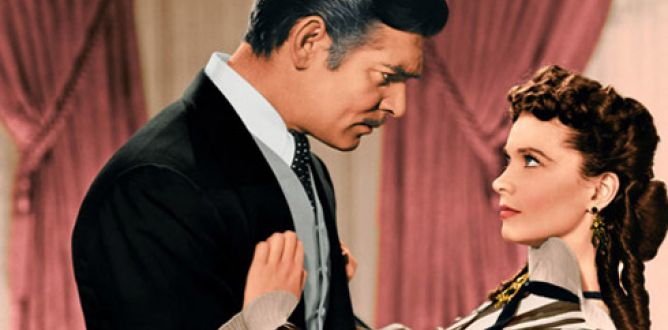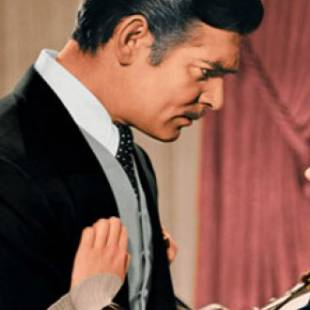Gone With The Wind Parent Guide
The Civil War threatens to huff and puff and blow Scarlett's house away.
Parent Movie Review
To begin with, I must confess I’ve never been smitten by Gone With the Wind. Winner of ten Academy Awards, credited with the biggest box office of all time, held up as one of Hollywood’s greatest cinematic achievements, and leaving an indelible mark on audiences for decades—am I the only one who doesn’t get it?
Sure, the cinematography is wonderful, the sets lavish, the costumes incredible, the musical score sweeping, and the film epic in every way. But what is all the window dressing for?
I suppose the obvious answer is Scarlett O’Hara (who incidentally, literally does clothe herself in velvet curtains during one scene). The central character in this film adaptation of Margaret Mitchell’s best selling novel, Scarlett (played by Vivien Leigh) is the eldest daughter of a wealthy plantation owner. Fancying Ashley Wilkes (Leslie Howard), the heir to a neighboring estate, the pampered lass is thunderstruck when he chooses to comply with his family’s wishes and marry his cousin Melanie Hamilton (Olivia De Havilland) instead of her!
Stormy temper tantrums and floods of tears don’t change his mind, but Ashley does confess he admires Scarlett’s spirit and passion. His flattering words are enough to keep alive the southern belle’s romantic notion that the soft-spoken gentleman is secretly in love with her. (I suspect Ashley’s kindly labels are also intended to identify Scarlett’s redeeming qualities to viewers, otherwise we might have mistaken them for stubbornness and selfishness!)
Meanwhile, the American Civil War explodes upon the peaceful pastoral existence these characters reside in. Scarlett refuses to worry her pretty little head about such trivial matters as political disputes; yet bit-by-bit the winds of war erode every part of the only lifestyle she has ever known. Thanks to her “spirit and passion,” the stubborn girl survives the devastation by putting her own selfish desires first, swearing she will do what ever it takes—even lying, cheating, stealing and murdering—to regain her former wealth and position.
Over the course of this nearly four-hour movie, the indomitable Scarlett does in fact do all of these things, and a few more besides. Shamelessly using her womanly whiles for personal gain, the dark-haired beauty weds for revenge and money, agrees to sell her virtue, denies her spouse his husbandly rights, engages in unethical business practices, and kills a man in self-defense.
Still, everyone loves Scarlett, especially the dashing rogue Rhett Butler (Clark Gable) who is enamored with her good looks—and of course her spirit and passion. When her previous husbands conveniently die (in the name of plot development), the two unite in not-so-happy matrimony, because the bride continues to harbor unholy feelings for the married Ashley.
Along the way, the film alludes to some other issues too, like slavery, unwed pregnancy, vigilante law enforcement, prostitution, rape, gambling, and alcoholism. While skirting most of the details, racial slurs, flirting, depictions of women in petticoats, passionate kisses exchanged between a couple who are not married to each other, as well as smoking and drinking, are included. The only consequences addressed with any degree of depth, are the ravages of the fighting. Wounded and dying soldiers are shown, although the violence and gore are kept to a minimum.
So what is the charm of this blockbuster? Some say it is a result of an incredible three-year-long promotional push from the studio.
Others, who are more analytical, suggest that Scarlett represent the spirit and passion of the Old South. Certainly there is a case to support a sentimental affection for this society of “Cavaliers and cotton fields… of knights and their ladies fair, of master and of slave,” where “gallantry took its last bow.” Quoting the movie’s opening title screen, the almost mournful declaration continues, “Look for it only in books, for it is no more than a dream remembered, a civilization gone with the wind…”
Perhaps it is Scarlett’s tenacity. Bloodied but not bowed, the resilient woman rises after each blow, gaining strength from her love of the land.
Or maybe she is merely an anti-hero who eventually reaps the rewards of her self-centered heart. If that’s the case however, why do so many fans of the film feel sorry for her?
Personally, I find Scarlett to be spoiled, conceited, and sharp-tongued. She gives no indication of growing or learning from her experiences, and displays her one true color again when she responds to the loss of the most significant person in her life by whimpering, “What am I going to do when you’re gone?”
While no one can deny Gone With the Wind‘s enduring place in film history, when it comes to feeling any sympathy for the story, frankly my dear…
Directed by Victor Fleming. Starring Vivien Leigh, Clark Gable. Running time: 238 minutes. Theatrical release January 17, 1941. Updated July 17, 2017Gone With The Wind Parents' Guide
“Body image” is a trendy phrase used to describe the way we see ourselves in relation to society’s definition of beauty. What Old South body image expectations are we privy to when Scarlett is commanded to eat at home before she goes to a barbeque at Twelve Oaks, so that in public her appetite will appear bird like? Are we still struggling with issues like these today?
Rhett accuses Scarlett of believing she can fix any problem simply by saying sorry. Why does he feel an apology isn’t always enough? Do you agree or disagree with him?
Scarlett has one unattainable obsession her whole life. How did focusing on the thing she couldn’t have effect her ability to enjoy the things she could have?
For an in-depth look at this motion picture, check out: http://www.filmsite.org/gone.html
This movie is based on Margaret Mitchell’s best selling novel.
Home Video
The most recent home video release of Gone With The Wind movie is September 30, 2014. Here are some details…
Gone With the Wind: 75th Anniversary Collection
Release Date: 30 September 2014
Gone With the Wind releases in a 75th Anniversary Collection (Blu-ray) on September 30, 2014.
Gone With the Wind: The Scarlett Edition [Blu-ray]
Release Date: 13 April 2010
Gone With the Wind blows onto Blu-ray disc on April 13, 2010. The Scarlett Edition offers:
- Commentary by historian Rudy Behlmer.
- About the Movie featurettes
- About the Cast featurettes
- 1939: Hollywood’s Greatest Year (Documentary about Hollywood’s watershed year narrated by Kenneth Branagh)
- Gone with the Wind: The Legend Lives On: (Explores the legacy of the classic film through interviews, footage and visits to historical sites, events and museums)
- Moviola: The Scarlett O’Hara Wars (1980 WBTV Special)
- Exclusive HD Content: MGM -When the Lion Roars
Related home video titles:
God’s and Generals is another epic-length film that looks at the American Civil War, but from the male perspective. Also set in the same time period, the classic Little Women (the 1949 original, or the 1994 remake) follows the fancies and follies of a family of sisters.



